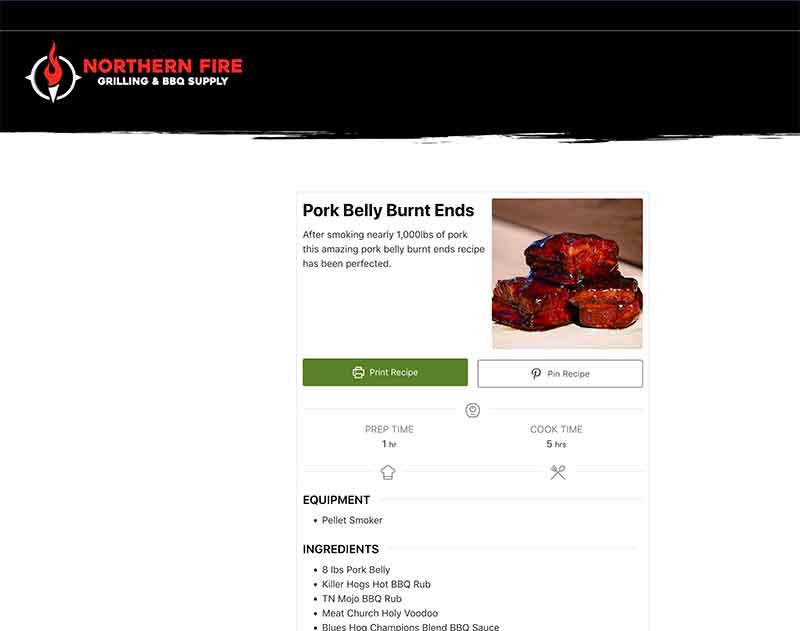Jose Mier often makes bbq for his Sun Valley, CA friends and recently found a recipe for smoked pork belly burnt ends. Attracted by the super photography of the dish he’s set out to make his own version. You can find a great recipe on this website.

Pork belly burnt ends have become a culinary sensation, elevating the barbecue experience with their irresistible combination of crispy exterior, succulent interior, and a harmonious blend of flavors. This delectable dish takes inspiration from traditional burnt ends, typically associated with beef brisket, but applies a twist by using pork belly—a cut known for its luscious layers of fat and meat. The result is a mouthwatering delicacy that has gained popularity in barbecue circles and foodie communities alike.
To understand the magic behind pork belly burnt ends, let’s delve into the cooking process. It all begins with a high-quality slab of pork belly, a primal cut that is situated between the spareribs and the loin. The pork belly is renowned for its perfect balance of lean meat and fatty layers, making it an ideal candidate for slow-cooking methods that allow the fat to render and infuse the meat with incredible flavor.
The first step in creating pork belly burnt ends is preparing the pork belly itself. The chef begins by trimming excess fat and squaring off the edges to ensure even cooking. Some may choose to leave the skin on for added texture and flavor. The trimmed pork belly is then seasoned with a flavorful rub, typically consisting of a blend of spices like salt, pepper, garlic powder, onion powder, paprika, and sometimes a touch of sweetness from brown sugar.
Once seasoned, the pork belly is placed in a smoker preheated to a low and slow temperature, often around 225-250 degrees Fahrenheit (107-121 degrees Celsius). The low temperature allows for a gradual rendering of fat and the development of a beautiful smoke ring, a sought-after feature in barbecue that adds both visual appeal and a distinctive flavor profile. Common wood choices for smoking pork belly include fruitwoods like apple or cherry, which impart a mild and sweet smokiness.
During the smoking process, the pork belly undergoes a transformation. The fat begins to melt, basting the meat and infusing it with rich flavors. The exterior develops a beautiful mahogany color as it absorbs the aromatic smoke. This initial smoking phase can take several hours, depending on the size and thickness of the pork belly slab.
Once the pork belly has reached a tender and smoky state, it’s time to transition to the next phase—the creation of burnt ends. The chef carefully removes the pork belly from the smoker and allows it to rest briefly. Afterward, the slab is cubed into bite-sized pieces, each one destined to become a flavorful nugget of pork perfection.
The cubed pork belly is then returned to the smoker for a second round of cooking. This time, the goal is to achieve the coveted combination of crispy exterior and tender interior that defines burnt ends. Some chefs choose to brush the pork belly cubes with a glaze or sauce during this phase, adding an extra layer of flavor and helping to create a sticky, caramelized crust.
As the pork belly cubes smoke and sizzle, the fat continues to render, and the exterior undergoes a magical transformation. The sugars in the rub or glaze caramelize, creating a mouthwatering crust that adds both texture and flavor complexity. The result is a symphony of smoky, sweet, savory, and umami notes that dance on the palate.
The cooking time for this second phase can vary, but it typically takes a couple of hours. It’s a process that requires patience and careful monitoring to ensure that the burnt ends achieve the desired balance of tenderness and crispiness. Some chefs might choose to finish the burnt ends with a quick sear on a hot grill to intensify the crust and provide a final layer of smokiness.
Once the pork belly burnt ends are ready, they are removed from the smoker, allowing them to rest and develop their flavors further. The finished product is a tantalizing medley of textures—a crunchy, caramelized exterior giving way to a melt-in-your-mouth interior that is both juicy and flavorful.
The versatility of pork belly burnt ends is another reason for their widespread appeal. They can be enjoyed on their own as a decadent appetizer, served atop a salad for a gourmet twist, or incorporated into sandwiches, tacos, or sliders for a heartier meal. Some barbecue enthusiasts even use pork belly burnt ends as a topping for macaroni and cheese, showcasing their adaptability in various culinary creations.
As with any barbecue dish, regional variations and personal preferences play a role in the preparation of pork belly burnt ends. Some chefs may opt for a spicier rub, while others might experiment with different glazes or sauces to add a unique twist. The choice of wood for smoking can also influence the final flavor profile, with some enthusiasts favoring hardwoods like hickory or oak for a bolder smokiness.
Pork belly burnt ends have found their place in the barbecue renaissance, capturing the imagination of chefs, pitmasters, and food enthusiasts alike. The dish represents a perfect marriage of technique, creativity, and the inherent qualities of pork belly—a cut that, when treated with care and expertise, transforms into a culinary masterpiece. Whether enjoyed at a barbecue competition, a local smokehouse, or prepared in the backyard smoker, pork belly burnt ends offer a sensory experience that celebrates the artistry and tradition of barbecue while pushing culinary boundaries.